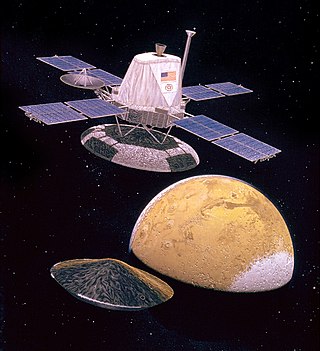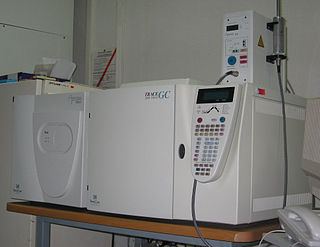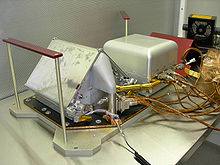
The Viking program consisted of a pair of identical American space probes, Viking 1 and Viking 2, which landed on Mars in 1976. The mission effort began in 1968 and was managed by the NASA Langley Research Center. Each spacecraft was composed of two main parts: an orbiter designed to photograph the surface of Mars from orbit, and a lander designed to study the planet from the surface. The orbiters also served as communication relays for the landers once they touched down.

Viking 1 was the first of two spacecraft, along with Viking 2, each consisting of an orbiter and a lander, sent to Mars as part of NASA's Viking program. The lander touched down on Mars on July 20, 1976, the first successful Mars lander in history. Viking 1 operated on Mars for 2,307 days or 2245 Martian solar days, the longest Mars surface mission until the record was broken by the Opportunity rover on May 19, 2010.

Mass spectrometry (MS) is an analytical technique that is used to measure the mass-to-charge ratio of ions. The results are presented as a mass spectrum, a plot of intensity as a function of the mass-to-charge ratio. Mass spectrometry is used in many different fields and is applied to pure samples as well as complex mixtures.

The Mars Polar Lander, also known as the Mars Surveyor '98 Lander, was a 290-kilogram robotic spacecraft lander launched by NASA on January 3, 1999, to study the soil and climate of Planum Australe, a region near the south pole on Mars. It formed part of the Mars Surveyor '98 mission. On December 3, 1999, however, after the descent phase was expected to be complete, the lander failed to reestablish communication with Earth. A post-mortem analysis determined the most likely cause of the mishap was premature termination of the engine firing prior to the lander touching the surface, causing it to strike the planet at a high velocity.

Phoenix was an uncrewed space probe that landed on the surface of Mars on May 25, 2008, and operated until November 2, 2008. Phoenix was operational on Mars for 157 sols. Its instruments were used to assess the local habitability and to research the history of water on Mars. The mission was part of the Mars Scout Program; its total cost was $420 million, including the cost of launch.

Gas chromatography–mass spectrometry (GC–MS) is an analytical method that combines the features of gas-chromatography and mass spectrometry to identify different substances within a test sample. Applications of GC–MS include drug detection, fire investigation, environmental analysis, explosives investigation, food and flavor analysis, and identification of unknown samples, including that of material samples obtained from planet Mars during probe missions as early as the 1970s. GC–MS can also be used in airport security to detect substances in luggage or on human beings. Additionally, it can identify trace elements in materials that were previously thought to have disintegrated beyond identification. Like liquid chromatography–mass spectrometry, it allows analysis and detection even of tiny amounts of a substance.

In 1976 two identical Viking program landers each carried four types of biological experiments to the surface of Mars. The first successful Mars landers, Viking 1 and Viking 2, then carried out experiments to look for biosignatures of microbial life on Mars. The landers each used a robotic arm to pick up and place soil samples into sealed test containers on the craft.

Isotope-ratio mass spectrometry (IRMS) is a specialization of mass spectrometry, in which mass spectrometric methods are used to measure the relative abundance of isotopes in a given sample.

The Lunar and Planetary Laboratory (LPL) is a research center for planetary science located in Tucson, Arizona. It is also a graduate school, constituting the Department of Planetary Sciences at the University of Arizona. LPL is one of the world's largest programs dedicated exclusively to planetary science in a university setting. The Lunar and Planetary Lab collection is held at the University of Arizona Special Collections Library.

Evolved gas analysis (EGA) is a method used to study the gas evolved from a heated sample that undergoes decomposition or desorption. It is either possible just to detect evolved gases using evolved gas detection (EGD) or to analyse explicitly which gases evolved using evolved gas analysis (EGA). Therefore different analytical methods can be employed such as mass spectrometry, Fourier transform spectroscopy, gas chromatography, or optical in-situ evolved gas analysis.

Evidence for carbonates on Mars was first discovered in 2008. Previously, most remote sensing instruments such as OMEGA and THEMIS—sensitive to infrared emissivity spectral features of carbonates—had not suggested the presence of carbonate outcrops, at least at the 100 m or coarser spatial scales available from the returned data.
John Hoffman was a space scientist who developed instruments for Apollo 15, Apollo 16, Apollo 17, the Pioneer Venus project, and Giotto mission. He also designed the mass spectrometer for the Phoenix Mars Lander mission in May 2008. He was a professor of physics at the University of Texas at Dallas.
The mineralogy of Mars is the chemical composition of rocks and soil that encompass the surface of Mars. Various orbital crafts have used spectroscopic methods to identify the signature of some minerals. The planetary landers performed concrete chemical analysis of the soil in rocks to further identify and confirm the presence of other minerals. The only samples of Martian rocks that are on Earth are in the form of meteorites. The elemental and atmospheric composition along with planetary conditions is essential in knowing what minerals can be formed from these base parts.
Rosalind Franklin, previously known as the ExoMars rover, is a planned robotic Mars rover, part of the international ExoMars programme led by the European Space Agency and the Russian Roscosmos State Corporation. The mission was scheduled to launch in July 2020, but was postponed to 2022. The 2022 Russian invasion of Ukraine has caused an indefinite delay of the programme, as the member states of the ESA voted to suspend the joint mission with Russia; in July 2022, ESA terminated its cooperation on the project with Russia. As of May 2022, the launch of the rover is not expected to occur before 2028 due to the need for a new non-Russian landing platform.

Sample Analysis at Mars (SAM) is a suite of instruments on the Mars Science Laboratory Curiosity rover. The SAM instrument suite will analyze organics and gases from both atmospheric and solid samples. It was developed by the NASA Goddard Space Flight Center, the Laboratoire des Atmosphères Milieux Observations Spatiales (LATMOS) associated to the Laboratoire Inter-Universitaire des Systèmes Atmosphériques (LISA), and Honeybee Robotics, along with many additional external partners.

Curiosity is a car-sized Mars rover exploring Gale crater and Mount Sharp on Mars as part of NASA's Mars Science Laboratory (MSL) mission. Curiosity was launched from Cape Canaveral (CCAFS) on November 26, 2011, at 15:02:00 UTC and landed on Aeolis Palus inside Gale crater on Mars on August 6, 2012, 05:17:57 UTC. The Bradbury Landing site was less than 2.4 km (1.5 mi) from the center of the rover's touchdown target after a 560 million km (350 million mi) journey.

CheMin, short for Chemistry and Mineralogy, is an instrument located in the interior of the Curiosity rover that is exploring the surface of Gale crater on Mars. David Blake, from NASA Ames Research Center, is the Principal Investigator.

Icebreaker Life is a Mars lander mission concept proposed to NASA's Discovery Program. The mission involves a stationary lander that would be a near copy of the successful 2008 Phoenix and InSight spacecraft, but would carry an astrobiology scientific payload, including a drill to sample ice-cemented ground in the northern plains to conduct a search for biosignatures of current or past life on Mars.

The Martian Moons eXploration (MMX) is a robotic space probe set for launch in 2024 to bring back the first samples from Mars' largest moon Phobos. Developed by the Japan Aerospace Exploration Agency (JAXA) and announced on 9 June 2015, MMX will land and collect samples from Phobos once or twice, along with conducting Deimos flyby observations and monitoring Mars's climate.
The Mars Organic Molecule Analyser (MOMA) is a mass spectrometer-based instrument on board the Rosalind Franklin rover to be launched in 2028 to Mars on an astrobiology mission. It will search for organic compounds in the collected soil samples. By characterizing the molecular structures of detected organics, MOMA can provide insights into potential molecular biosignatures. MOMA will be able to detect organic molecules at concentrations as low as 10 parts-per-billion by weight (ppbw). MOMA examines solid crushed samples exclusively; it does not perform atmospheric analyses.




















